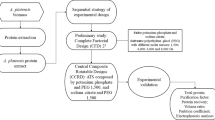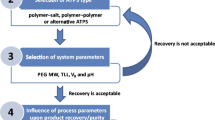Abstract
In this study, several chemical treatment techniques commonly used for protein extraction were investigated for recovering glutaryl-7-aminocephalosporanic acid acylase (GLA) from recombinant E. coli cells. The best results were obtained by the combined use of cetyltrimethylammonium bromide (CTAB) and KCl. Subsequently, various extraction conditions, such as cation salt, concentrations of CTAB and KCl, extraction temperature, extraction time, and biomass, were optimized to further enhance the release yield and specific activity of GLA. Our results showed that 110% of GLA was released after treatment with 0.5% CTAB (w/v, %) and 0.3 M KCl at 10°C for 12 h, and its specific activity in this extracting solution was approximately 1.5 times higher as compared to that obtained by sonication. This extraction method could avoid the inactivation of GLA caused by drastic mechanical methods, and also enhance its specific activity for industrial extraction.
Similar content being viewed by others
References
Kim, Y., K. H. Yoon, Y. Khang, S. Turley, and W. G. J. Hol (2000) The 2.0 A crystal structure of cephalosporin acylase. Structure 8: 1059–1068.
Grçger, H., Y. Asano, U. T. Bornscheuer, and J. Ogawa (2012) Development of biocatalytic processes in Japan and Germany: From research synergies to industrial applications. Chem. Asian J. 7: 1138–1153.
Sonawane, V. C. (2006) Enzymatic modifications of cephalosporins by cephalosporin acylase and other enzymes. Crit. Rev. Biotechnol. 26: 95–120.
Li, Y., J. F. Chen, W. H. Jiang, X. Mao, G. P. Zhao, and E. D. Wang (1999) In vivo post-translational processing and subunit reconstitution of cephalosporin acylase from Pseudomonas sp 130. Eur. J. Biochem. 262: 713–719.
Ma, X. Q., E. Z. Su, Y. Zhu, S. W. Deng, and D. Z. Wei (2013) High-level expression of glutaryl-7-aminocephalosporanic acid acylase from Pseudomonas diminuta NK703 in Escherichia coli by combined optimization strategies. J. Biotechnol. 168: 607–615.
Volontè, F., F. Marinelli, L. Gastaldo, S. Sacchi, M. S. Pilone, L. Pollegioni, and G. Molla (2008) Optimization of glutaryl-7-aminocephalosporanic acid acylase expression in E. coli. Protein. Expr. Purif. 61: 131–137.
Zhou, H., H. M. Yu, H. Luo, Y. Y. Shi, X. F. Ma, and Z. Y. Shen (2007) Inducible and constitutive expression of glutaryl-7-aminocephalosporanic acid acylase by fusion to maltose-binding protein. Enz. Microb. Technol. 40: 555–562.
Kim, D. W. and K. H. Yoon (2001) Cloning and high expression of glutaryl 7-aminocephalosporanic acid acylase gene from Pseudomonas diminuta. Biotechnol. Lett. 23: 1067–1071.
Li, Y., W. H. Jiang, Y. L. Yang, G. P. Zhao, and E. D. Wang (1998) Overproduction and purification of glutaryl-7-amino cephalosporanic acid acylase. Protein Expr. Purif. 12: 233–238.
Zheng, Y. G., Y. Li, J. F. Chen, W. H. Jiang, G. P. Zhao, and E. D. Wang (2001) Two novel engineered bacteria for secretory expression of glutaryl7-amino-cephalosporanic acid acylase. Biotechnol. Lett. 23: 1781–1787.
Novella, I. S., C. Fargues, and G. GréVillot (1994) Improvement of the extraction of penicillin acylase from Escherichia coli cells by a combined use of chemical methods. Biotechnol. Bioeng. 44: 379–382.
Bansal-Mutalik, R. and V. G. Gaikar (2003) Cell permeabilization for extraction of penicillin acylase from Escherichia coli by reverse micellar solutions. Enz. Microb. Technol. 32: 14–26.
Falconer, R. J., B. K. O’Neill, and A. P. J. Middelberg (1997) Chemical treatment of Escherichia coli: I. Extraction of intracellular protein from uninduced cells. Biotechnol. Bioeng. 53: 453–458.
Tavares, F. and A. Sellstedt (2000) A simple, rapid and nondestructive procedure to extract cell wall-associated proteins from Frankia. J. Microbiol. Methods. 39: 171–178.
Cheng, S. W., D. Z. Wei, and Q. X. Song (2006) Extraction penicillin G acylase from Alcaligenes faecalis in recombinant Escherichia coli with cetyl-trimethylammoniumbromide. Biochem. Eng. J. 32: 56–60.
Wang, P. X., X. Y. Gong, E. Z. Su, J. L. Xie, and D. Z. Wei (2012) A facile pretreatment method for efficient immobilization of penicillin G acylase. Biochem. Eng. J. 56: 17–22.
Sizmann, D., C. Keilmann, and A. Bock (1990) Primary structure requirements for the maturation in vivo of penicillin acylase from Escherichia coli ATCC 11105. Eur. J. Biochem. 192: 143–151.
Kim, J. K., I. S Yang, H. J. Shin, K. J. Cho, E. K. Ryu, S. H. Kim, S. S Park, and K. H. Kim (2005) Insight into autoproteolytic activation from the structure of cephalosporin acylase: A protein with two proteolytic chemistries. PNAS. 103: 1732–1737.
Kheirolomoom, A., M. Ardjmand, H. Fazelinia, and A. Zakeri (2001) Isolation of penicillin G acylase from Escherichia coli ATCC 11105 by physical and chemical treatments. Biochem. Eng. J. 8: 223–227.
Balasingham, K., D. Warburton, P. Dunnill, and M. D. Lilly (1972) The isolation and kinetics of penicillin amidase from E. coli. Biochim. Biophys. Acta. (BBA)-Enzymol. 276: 250–256.
Laemmli, U. K. (1970) Cleavage of structural proteins during the assembly of the head of bacteriophage T4. Nature 227: 680–685.
Nagalakshmi, V. and J. S. Pai (1994) Permeabilization of Escherichia coli cells for enhanced penicillin acylase activity. Biotechnol. Tech. 8: 431–434.
Felix, H. (1982) Permeabilized cells. Anal Biochem. 120: 211–234.
Falconer, R. J., B. K. O’Neill, and A. P. J. Middelberg (1998) Chemical treatment of Escherichia coli: II. Direct extraction of recombinant protein from cytoplasmic inclusion bodies in intact cells. Biotechnol. Bioeng. 57: 381–386.
Ignatova, Z., S. Stoeva, B. Galunsky, C. Hörnle, A. Nurk, E. Piotraschke, W. Voelter, and V. Kasche (1998) Proteolytic processing of penicillin amidase from Alcaligenes faecalis cloned in E. coli yields several active forms. Biotechnol. Lett. 20: 977–982.
Vaara, M. (1981) Increased outer membrane resistance to ethylenediaminetetraacetate and cations in novel lilip A mutants. J. Bacteriol. 148: 426–434.
Brass, J. M., W. Boos, and R. Hengge (1981) Reconstitution of maltose transport in malB mutants of Escherichia coli through calcium-induced disruptions of the outer membrane. J. Bacteriol. 146: 10–17.
Nikaido, H. and M. Vaara (1985) Molecular basis of bacterial outer membrane permeability. Microbiol. Rev. 49: 1–32.
Author information
Authors and Affiliations
Corresponding authors
Rights and permissions
About this article
Cite this article
Ma, Xq., Su, Ez., Deng, Sw. et al. An effective method for extraction of glutaryl-7-aminocephalosporanic acid acylase from recombinant E. coli cells. Biotechnol Bioproc E 20, 718–724 (2015). https://doi.org/10.1007/s12257-013-0607-7
Received:
Revised:
Accepted:
Published:
Issue Date:
DOI: https://doi.org/10.1007/s12257-013-0607-7




